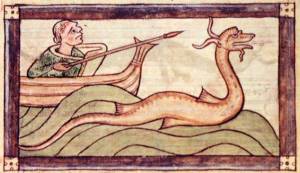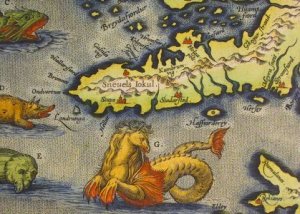In the last week, a number of websites have informed their readers that recent scientific evidence shows that roughly half of Viking warriors were female. Tor.com proclaims, “Better Identification of Viking Corpses Reveals: Half of the Warriors Were Female,” while Cory Doctorow of BoingBoing declares that “Half the Remains of Slain Vikings in England Are Female.” Wow, cool! How is it possible that we didn’t know this before? Well, according to Emma Cueto of Bustle, it’s because of evil sexist scholars. Her post boasts the level-headed title, “Women Viking Warriors Existed, Confounding Sexist Scientists Everywhere.” She claims that sexist archaeologists have used sexist assumptions to come to sexist conclusions rather than looking at the actual data:
After all, if archeologists [sic] are letting their sexist assumptions affect the way they collect and classify data about the past, that has some pretty troubling implications. For instance, when people argue in favor of “traditional” gender roles, they often cite history, saying that since this is how things have always been, clearly it’s natural and therefore right.
I’d like to see an example of a modern archaeologist saying that something is natural and right because it was common in the past: “Well, human sacrifice is traditional. It’s been practiced for millennia. So I’ve slaughtered a couple of the slower diggers to appease the gods. What? Stop looking at me like that!”

Human Sacrifice: Traditional, Therefore Required*
Cueto continues:
And if we are imposing our own ideas about gender back onto the past, that’s not only bad for the modern fight for gender equality, but it’s also just bad science.
So if archeologists could stop making sexist assumptions and maybe start being thorough researchers, that would great. Sound good, guys?
She’s right: doing thorough research is important; looking at as many types of evidence as possible is important. Scholars in all fields should stop imposing their own ideas about gender onto the past, and they should look at the actual data.
It is especially ironic, then, that she appears to be imposing her ideas about gender roles and gender equality onto the Viking Age and that she hasn’t looked at the data. That is to say, neither she nor many of the other writers seem actually to have read the scholarly article that inspired them.
They seem not, for instance, to have noticed its date of publication: 2011. Even the USA Today and Jezebel articles that actually get cited and quoted are from 2011. It’s not entirely clear why this story has been resurrected, although it may have something to do with the popularity of the History Channel’s series Vikings, which features a shield-maiden named Lagertha.

Photo: Jonathan Hession,
The History Channel
NOT A REAL VIKING WOMAN!
The actual scholarly article, “Warriors and Women: The Sex Ratio of Norse Migrants to Eastern England up to 900 AD” by Shane McLeod has nothing to do with female Viking warriors. It only tangentially relates to warriors at all. He’s talking about migrants, early Norse settlers. His focus is very narrow: Norse burials in eastern England from the latter half of the ninth century. Specifically, he discusses Scandinavian burials contemporary with the incursions of the Great Heathen Army (865-878) and a second army that rampaged in the 890s. Considering the narrow focus, it’s dangerous to extrapolate the data to the entire Viking world.
Extrapolation is even more dangerous when we consider that he is discussing fourteen burials. Fourteen. According to osteological examination, seven of the skeletons** were male, six were female, and one couldn’t be sexed because it was a juvenile. This data suggests that there may have been a higher percentage of female settlers during this period than has previously been assumed. It was commonly believed that males–warriors–came first. After they claimed land and began to settle, Norse women began to join them in larger numbers, while many Norsemen married Anglo-Saxon women. McLeod isn’t the first to suggest that more women arrived earlier than was previously thought, although he provides some data to support his contention.
The sample size is, however, tiny. And his findings don’t necessarily contradict the idea that there were many intermarriages between the Norse and the Anglo-Saxons or that more Norse women arrived later.
Here are some things the article doesn’t say: McLeod never says that any of the remains belong to “the slain.” He never claims the female migrants were warriors. Indeed, he refers on several occasions to women and children who accompanied the armies. So where does this whole “warrior woman” thing come from, and what’s up with the sexist archaeologists?
Well, he points out that the sex of Viking Age human remains is often determined by looking at grave goods (this is true of other pagan burials as well). He believes that grave goods may not always be a reliable indication of sex, and he focuses instead on remains that have been sexed by an examination of the bones. And this is fair enough. All data should be taken into account: both grave goods and osteological examination.
Of the fourteen burials he discusses, most of the male remains were found with items traditionally associated with male burials, and most of the female remains were found with items traditionally associated with female burials. There are two exceptions. One is a double burial, a female with the juvenile of undetermined sex. These two were buried with “sword hilt grip, shield clamps, knife” (Table 2, p. 345). Of course, we don’t know which of the grave’s occupants was the proud owner of these items. Another woman was buried with “axe, seaxes, sword pieces in mortuary” (Table 2, p. 345).
So, that’s it–that’s the big sexist scandal. Now, there are a few things to keep in mind. For one thing, osteological examination isn’t always possible. Sometimes there simply isn’t enough bone evidence. And osteological evidence can also be problematic. In fact, McLeod does a good job of showing exactly how difficult it is to make many determinations when dealing with very old human remains. Not only is the sex of the remains a problem, so is determining date, establishing whether the remains are really Norse, etc. So, yes, consider the bone evidence, but don’t ignore the evidence of grave goods. The article does not reveal some sort of nefarious sexist scandal in the field of archaeology.
So are the few women who were buried with weapons warriors? Possibly, but it’s difficult to say for sure. We don’t really know why they were buried with these items. Were there female Vikings? Well, the Vikings Wiki certainly things so:
Shield-maidens were women who chose to fight as warriors alongside the other Viking men in the pagan Scandinavia.
They took part in warfare, and they played vital strategic roles in the battlefield, where the shield-maidens were either part of the front-lines in their shield-wall formation, or were the ones who helped close the gaps in their defense by picking up the shields of the fallen and holding them up themselves. Scholars like Britt-Mari Näsström suggest that sheild-maidens [sic] where transsexual women who where adapted as warriors to fit in.
Wow, that’s super-specific. And there’s absolutely no evidence for it. Shield-maidens are often associated with valkyries, who were mythological semi-divine women–not real, historical warrior women. Lagertha, the shield-maiden from Vikings, may have started out as a goddess or giantess. Lagertha, along with several other warrior women, also appears in Saxo Grammaticus’s Gesta Danorum, but these are all within the realm of legend rather than history. Saxo also disapprovingly presents them as transgressing normal female behavior, and they are ultimately defeated. Also in the realm of legend is Hervör of Hervarar saga ok Heiðreks.
In semi-historical works, there are a few women who take up weapons. Freydis, the daughter of Eirik the Red and sister or half-sister of Leif Eiriksson, has a great warrior moment in the Saga of Eirik the Red. She has accompanied Thorfinn Karlsefni to Vinland. When the Norse retreat after an assault by the Skraelings (Native Americans), Freydis derides them for cowardice. Because she is heavily pregnant, she falls behind. When confronted by Skraelings, she picks up a sword from a dead man and slaps it against her breasts. This action scares off the Skraelings. She is not, however, a Viking warrior.
Scandinavian women of the Viking era (particularly Icelandic women) had more rights than many other European women, and Old Norse literature is filled with strong, interesting, powerful, influential, respected, and occasionally villainous women, but most of them are not warriors. Judith Jesch, Professor of Viking Studies at the University of Nottingham, argues that women who took up weapons were rare in medieval Scandinavia:
Like most periods of human history, the Viking Age was not free from conflict, and war always impacts on all members of a society. It is likely that there were occasions when women had to defend themselves and their families as best they could, with whatever weapons were to hand. But there is absolutely no hard evidence that women trained or served as regular warriors in the Viking Age. Valkyries were an object of the imagination, creatures of fantasy rooted in the experience of male warriors. War was certainly a part of Viking life, but women warriors must be classed as Viking legend.
Swedish archaeologist and skeptic Martin Rundkvist agrees that warrior women were very rare during the Viking Age, and he argues that osteological sexing tends to support the evidence of grave goods:
[F]urnished burial is strongly gendered and this correlates with osteological sexing. Looking at richly furnished graves, you get weapon burials and jewellery burials, so dissimilar that you have to seriate them separately when you build chronology. The stuff they tend to share are things like pots and table knives. Almost always the weapon graves contain male-sex bones and the jewellery graves contain female-sex bones.
Every once in a very long while you get a jewellery grave with a single piece of weaponry in it, or vice versa. But in most cases those are cremation graves where it is impossible to know if (to pick a 6th century case from my dissertation about the Barshalder cemetery) the heavily armed cavalry man was buried with a dainty bead necklace around his neck or if his wife just put it on the pyre next to his feet as a parting gift. So it seems that if a few women were buried as warriors, their grave goods would be likely to be 100% weapon-gendered, not mixed.
Like Jesch, he agrees that women in rare circumstances may have fought to protect themselves, but that these were not Viking women:
Did any women ever fight? Yes, I’m sure some did, particularly when threatened by male warriors, as would have been an unfortunate fact of life in that barbaric age. But the ones who joined an armed retinue, lived the ideal warrior life and went to Valhalla must have been vanishingly few.
Finally, he argues that whether there were women warriors in the Viking world has no effect on gender issues today. He does not believe that tradition should guide contemporary actions. Clearly Dr. Rundkvist is not the sexist straw archaeologist that Cueto set up. He ends by saying,
The past is not our mirror and archaeology must resist attempts to use its results or bend its interpretations for political purposes today.
He clearly agrees with Cueto that archaeologists should follow the evidence and that they should not let “their sexist assumptions affect the way they collect and classify data about the past.” Unlike Cueto, however, he seems to believe archaeologists should follow the evidence even when it suggests that Viking warrior women were largely a myth.
*WickerManIllustration” by Unknown Original uploader was Midnightblueowl at en.wikipedia – Transferred from en.wikipedia; transfer was stated to be made by User:Midnightblueowl.. Licensed under Public domain via Wikimedia Commons –
*The remains were not necessarily complete skeletons. Some came from cremation burials.
ES
Sources:
Foss, Arild S. “Don’t Underestimate Viking Women.” ScienceNordic.
Jesch, Judith. “Viking Women, Warriors, and Valkyries.” British Museum Blog.
McLeod, Shane. “Warriors and Women: The Sex Ration of Norse Migrants to Eastern England up to 900 AD.” Early Medieval Europe 19.3 (2011): 332-353.
Rundkvist, Martin. “Shield Maidens! True or False?” Aardvarchaeology. ScienceBlogs.com.



 Posted by marknewbrook
Posted by marknewbrook 










